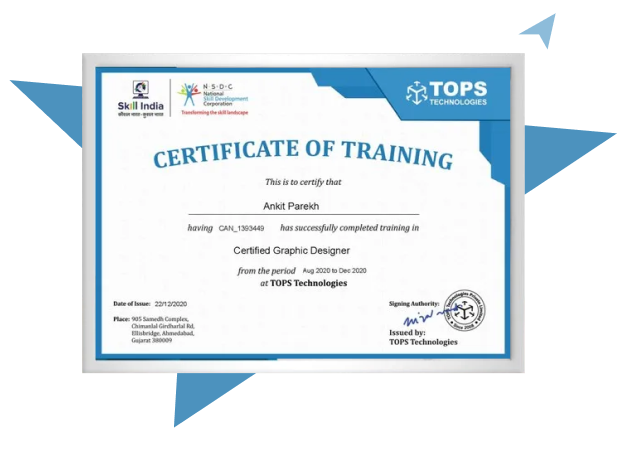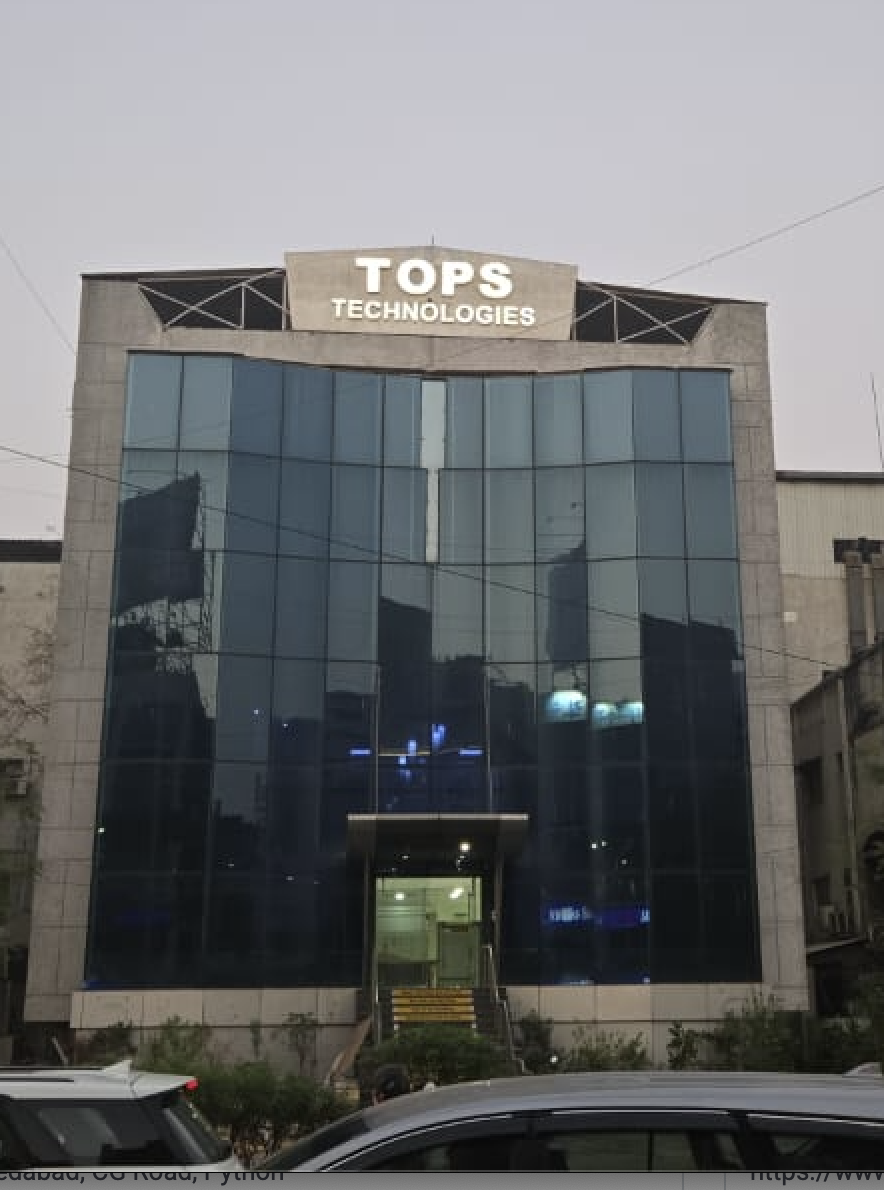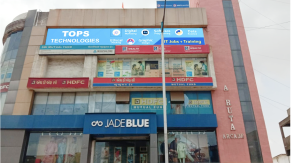Our Facts and Figures
1 Lac+
Student Placed
3000+
Companies TieUp
19+
Offices in India
50+
Industry Courses
Get 100% Job Assistance by enrolling in Best Selenium Training Certification Course with Live Project Training & Job Assurance. Learn Selenium Testing from experts at our institute!
Key Highlights
Limited Students Batch
Personalised Attention
Highly Qualified Teachers
Flexible Batch Timings
Interactive Learning
Live Projects
Career Support
Job Oriented Training
Selenium Course Highlights
Best Selenium Training in Ahmedabad
The buzzing IT industry in Ahmedabad is always on a lookout for some skillful Selenium developer. Mustering such high-on-demand skills can certainly fetch you an ideal job. TOPS Technologies offers the best Advanced Selenium Training in Ahmedabad that helps you master as an Automation Tester. The experienced faculties at TOPS Technologies help you to gain an in-depth understanding of the involved concepts like testing, quality analyst, software testing, etc.
All these concepts build your testing ability to better your knowledge with the Advanced Selenium. Pick the basics and advanced understanding of the Advanced Selenium course with TOPS Technologies experts who stimulate real-life scenarios that prepare you for the job.
Our Advance Selenium Training course covers Selenium IDE, Web Driver, Junit, API Testing, as well as overs Core Java. The Selenium Training Program also provides Placements to candidates undergoing this program with IT companies hiring Automation Testers. This course will help Manual Testers who want to switch to Automation Testing, Automation Testers looking for Advance Selenium training.
Since its inception, TOPS Technologies has shaped over 1 Lac students by re defying their careers and availing the best jobs in the IT industry. Take a bold step towards the future and get a risk-free demo at TOPS Technologies Ahmedabad Training Center. Our team will happily assist you with all the queries and concerns related to the advanced selenium training in Ahmedabad. TOPS Technologies has 4 centers around Ahmedabad which offer Selenium and Advance Selenium Training.
TOPS Technologies Ahmedabad Centers are located at C.G.Road, Maninagar, SG Road, Naranpura Bhuyangdev, & Ashram Road. Find your nearest training center and visit us for more details, Career Counselling, and free-demo Whatsapp or Call us.
40%
Average Salary Hike
4.5 Lacs
Highest Salary
3000+
Hiring Partners
Join Our Free Upcoming Webinar
How to Become a Data Scientist
16 Dec 2025, 04:00 PM
Trainer
Dhrumil Joshi
(Sr. Technical Trainer)
Graphic Designing Career
17 Dec 2025, 04:00 PM
Trainer
Parth Patel
(Sr. Technical Trainer)
Learn Python in 60 Minutes
18 Dec 2025, 04:00 PM
Trainer
Sanket Chauhan
(Sr. Technical Trainer)
Want to protect yourself against Malware
19 Dec 2025, 04:00 PM
Trainer
Faruk Pathan
(Sr. Technical Trainer)
Selenium Course Curriculum
Download Curriculum- Introduction to Selenium
- Introduction of Students
- Career in Selenium
- Working on Project and Assignment
- Using Lab
- What is automation testing?
- What is the use of automation testing?
- What do we need to Automate?
- What is Selenium?
- Advantages of Selenium
- What is the difference between Selenium and QTP?
- Different flavors in Selenium Basic
- IDE
- Selenium Web Driver/Selenium 2.0
- Selenium-Grid
- Selenium IDE Basic
- Installing Selenium IDE
- Selenium IDE icons
- Recording your first test with Selenium IDE
- Introducing the JAVA technology:
- Showing how to download, install, and configure the Java environment on a Windows system
- Java Keywords
- Java Data Types
- Declarations and Access Control
- Operators and Assignments
- Flow Control
- Typecasting
- Arrays
- Packages:
- Introduction to all predefined packages
- User Defined Packages
- Access Specifies
- Object Oriented Programming Concepts:
- Class
- Object
- Local, Instance and static variables
- This keyword
- Inheritance and Types
- Working with superclasses and subclasses
- Using types of polymorphism such as overloading, overriding, and dynamic binding
- Abstraction
- Encapsulation
- Abstract classes
- Interfaces
- String Processing:
- String manipulation with String Builder and String Buffer
- Essential String Methods
- Exceptions and Assertions:
- Introduction
- Exceptions categories
- Standard Java Exception classes
- Using Try-catch and finally clause
- I/O Streams:
- I/O using Java
- Files (Create/Read/Write operations on files)
- Collections:
- List, Set, and Map
- Why Web Driver?
- Downloading web driver Jars configuring in eclipse
- Architecture of selenium web driver
- Drivers for Firefox, IE, Chrome, iPhone, Android, etc.
- What is the difference between Selenium RC and WD
- Locators & Object Identification
- Tools to identify elements/objects
- Firebug
- IE Developer tools
- Google Chrome Developer tools
- Locating elements by ID
- Finding elements by name
- Finding elements by link text
- Finding elements by XPath
- Finding Elements by using CSS
- Summary
- Some Special IDE commands
- Write your own Selenium IDE script without record and playback
- Sample programs in Web Driver Intermediate
- Handle Text box
- Handle Hyperlink
- Handle Button and Checkbox
- Handle Radio Button and DropDown Controls
- Select value from DropDown
- Display all values
- Why Implicit wait and Implementation of Implicit wait
- Why Explicit wait and Implementation of Explicit wait
- Web Driver Fluent wait and Thread Sleep functionality
- Handling alerts box, Verifying the Alert Texts and verify pop-ups
- Handling confirmation messages
- Keyboard actions
- Mouse Actions
- Handling multiple tabs
- Preparing web driver test cases using customized x-path
- Identifying controls using x-path predefined functions
- Web Tables
- What is Web Table
- Extracting data from web tables
- Examples on static and dynamic Web Tables
- Junit Framework:
- Running Java Programs using JUnit
- Writing Selenium tests from scratch using JUnit Framework
- JUNIT Annotations
- JUNIT Methods
- Frequently used Selenium commands
- Test Suites using JUnit
- TestNGFrameWork
- Overview of TestNG
- Environment of TestNG
- Writing WebDriver Test Cases using TestNG and execution
- Basic Annotations of TestNG
- Ignore Test
- Dependency Test
- Parameterized Tests
- TestNG XML
- Report Generation
- Working with multiple browsers
- Executing Automation Test Cases in multiple browsers Sequentially
- Working with Chrome and IE browsers
- What is Firefox Profile And Implementation of Firefox Profile
- What is WebDriver Desired Capabilities class
- Validations and its usage in Automation test scripts
- Implementing Logs using Apache Log4j API
- Reading data from Property files using java program
- Reading and Writing data from/to Excel files using Apache POI API and JXL API
- Automation Test Frame Work
- How to develop Test automation framework in a live environment
- What is a framework
- Types of framework
- Data driven frame work
- Modular driven framework
- Keyword driven framework
- Hybrid Framework
- Maven Project Management Tool
- Introduction about maven
- High Level Overview
- Ant v/s Maven
- Installation of Maven
- Demo using Sample Maven Project
- Maven Structure
- Maven Dependencies
- Maven Repositories
- Maven Eclipse Integration
Our TOPS Training Centers in India
Course Key Features
Skills Covered
Job Roles
Get Training Certificate by Government
Recognized NSDC/Skill India

- National Skill Development Corporation
- Supported by the vision of PM Shri Narendra Modi
- Certification by NSDC SkillIndia
- Valid for all Jobs and College Training
- International Recognition

FAQ
What is the difference between absolute and relative XPath?
Absolute XPath follows the entire path from the root to the element, while relative XPath starts from the middle or a known node. Relative XPath is more reliable and maintainable.
Selenium uses the Select class to handle dropdowns. You can select options by visible text, value, or index to interact with standard dropdown menus.
Implicit waits apply globally and wait a fixed time before throwing an exception. Explicit waits are set for specific elements and wait until a condition is met or time expires.
Selenium cannot automate Captcha since it's meant to prevent bots. Instead, Captcha must be disabled in test environments or solved using third-party services.
Selenium handles JavaScript pop-ups using the Alert interface. You can accept, dismiss, or input text into alerts using methods like accept() and dismiss().
Page Object Model (POM) is a design pattern that enhances test maintenance and readability. It creates separate classes for each page, encapsulating element locators and actions.
The Actions class in Selenium allows simulation of mouse events like hover, drag-and-drop, right-click, and double-click using method chaining.
You can switch between windows or tabs using getWindowHandles() and switchTo().window(). This helps in testing multi-window workflows like login and payment gateways.
Selenium allows switching to frames using switchTo().frame() by index, name, or WebElement. This is essential when interacting with elements inside HTML frames or iframes.
Selenium doesn’t generate reports directly, but it can be integrated with tools like TestNG, JUnit, or ExtentReports to create detailed test execution reports.
Interview Questions
Selenium uses the Alert interface to manage browser pop-ups. Methods like accept(), dismiss(), getText(), and sendKeys() help interact with JavaScript alerts, confirmations, and prompts efficiently within automated scripts.
Frames and iframes can be accessed using switchTo().frame() by name, index, or WebElement. Always switch back to the default content using switchTo().defaultContent() once done. It’s crucial for interacting with content embedded in frames.
driver.close() closes the current browser tab, while driver.quit() closes all browser windows opened by the WebDriver session. Use quit() at the end of the test to release all associated resources and avoid memory leaks.
Data-driven testing can be implemented by integrating Selenium with Apache POI for Excel or using TestNG’s @DataProvider annotation. It allows feeding multiple sets of input data into the same test case for comprehensive coverage.
Selenium uses the TakesScreenshot interface to capture screenshots during test execution. Screenshots help in debugging failed test cases by providing visual confirmation of the application’s state at the time of failure.
Synchronization issues occur when the script executes faster than the browser loads. Using explicit waits with ExpectedConditions like visibilityOfElementLocated or elementToBeClickable ensures the element is ready before interaction.
Selenium Grid allows parallel test execution on multiple machines and browsers by distributing tests across a hub and connected nodes. It improves test efficiency and supports cross-platform and cross-browser compatibility testing.
XPath is a language for navigating XML and HTML documents. In Selenium, XPath helps locate elements using their attributes or hierarchical structure, especially when IDs or names are not available or dynamically generated.
Dropdowns are managed using the Select class in Selenium. You can select options using methods like selectByVisibleText(), selectByValue(), or selectByIndex(), depending on the test scenario requirements.
Tooltip texts are often present in the title attribute. You can fetch them using getAttribute("title") or use Actions class to hover and verify if the tooltip appears by validating the corresponding element’s text.
Latest Blogs
What is Selenium? Getting started with Selenium Au...
In this blog, readers will unravel the essence of Selenium as a premier tool for web application tes...
View full Blog








